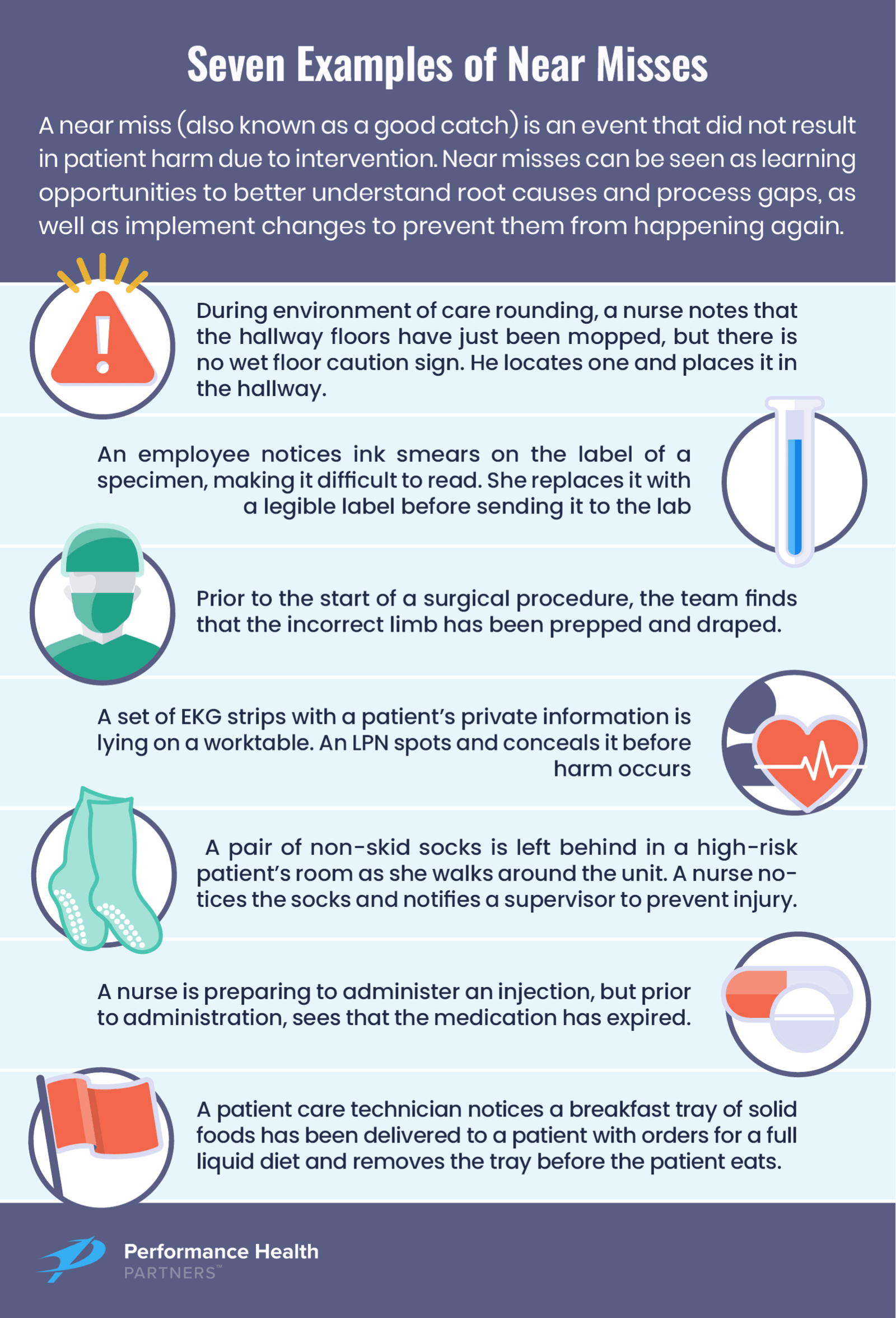3 min read
5 Examples of Good Catches in Healthcare & How to Implement a Near Miss Campaign
Performance Health Partners
March 19, 2024
Learn how to recognize common examples of good catches in healthcare that prevent harm before it reaches the patient.
What are Good Catches in Healthcare?
A good catch in healthcare is recognized as an employee interception of a potential safety event before a patient is harmed. Research suggests that near misses occur anywhere between three and 300 times before a harmful incident occurs. As such, near misses and good catches present healthcare organizations with opportunities for learning to reduce harmful events, which is why reporting near misses in healthcare should be a priority for all organizations, regardless of type or size.
5 Examples of Good Catches in Healthcare to Recognize
It is important that all employees can recognize common examples of good catches in healthcare that prevent patient harm before it reaches the patient. Below are five situations in which harm can likely occur when no action is taken.
1. Fall/Slip
Housekeeping mops up a coffee spill and forgets to place a wet floor caution sign. During an Environment of Care (EOC) Safety Rounding, an employee finds a wet floor sign and puts it in the hallway. This good catch prevented patients from slipping on a wet floor because of appropriate signage not in place during mopping.
2. Wrong Labeling
Smeared ink and faded print can make labels hard to read. Additionally, it can cause a recollect on laboratory specimens. An employee catching these mistakes and replacing improper labels before sending the specimen to the lab is considered a good catch and prevents a patient from experiencing an uncomfortable redraw.
3. Patient Privacy
A set of EKG strips with a patient’s private information is lying on a worktable. This is a threat to the HIPAA Security Rule which requires PHI to be always secured. If private information is left unattended, it could be viewed by another staff member, patient, or visitor who is unauthorized. An employee catching the exposed information and moving it before harm occurs is an example of a good catch.
4. Mobility Risk
Patients need to transfer and ambulate to maintain their strength while on bed rest. However, a pair of non-skid socks is left behind in a high-risk patient’s room as he or she takes a walk around the unit. A staff member notices the socks and notifies a supervisor to prevent patient injury.
5. Mealtime Assistance
A patient is on a puréed, level-3 fluids diet order. This diet consists of foods that require less chewing. A nurse performing a routine check-in noticed he received a dinner roll on his lunch tray and removed it. This is a good catch that could have prevented complications with post-operative care.
 Benefits of Implementing a Good Catch Program
Benefits of Implementing a Good Catch Program
A Good Catch campaign, also known as a near miss program, is an incentive-based program that fosters a culture of safety by training and encouraging staff to recognize and report risk before it harms a patient. These programs offer healthcare organizations the opportunity to increase incident reporting while defining gaps in system processes.
In March of 2018, American Data Network PSO celebrated the achievements made by 45 hospitals that participated in ADNPSO’s 2017 Good Catch Campaign. The pioneering organizations who participated in this study increased Near Miss reporting by 47% over baseline and provided concrete evidence of the learning that happens when Near Miss events are shared and studied.2
How to Establish a Good Catch Program
Implementing an effective good catch program begins by reviewing trends in system data and defining a goal for increasing reporting over time. Isolating data around near misses and good catches by month can be helpful in making this goal a reality.
Next, consider ways to improve current reporting processes. For organizations that use incident reporting software, this includes adding good catch reports into daily workflows. It is important to obtain senior leadership support during this process by demonstrating expected outcomes. Lastly, designate a skilled committee or team to manage the program and develop an action plan.
Three key elements of a good catch program are: communication, ease of use, and action.3 The program must be well-communicated to employees and easy to use in order to eliminate reporting barriers. Employers should also share details about actions taken in response to near misses and good catches.
How to Recognize Staff for Reporting Good Catches
It is important that all staff feel comfortable speaking out when a harmful event may occur, or when it has already occurred. Additionally, organizations must put a system in place to reinforce these good behaviors and celebrate a culture of reporting.
Meaningful rewards and recognition programs may include certificates, cash awards, gifts, time off from work, or company parties for anyone who demonstrates examples of good catches in healthcare and good reporting practices. Download our free guide below to learn more about improving reporting with technology solutions.
3. https://incident-prevention.com/blog/near-miss-and-good-catch-reporting/



